With my recent interest in the “Allure of Simple Wargaming” I decided to give Neil Thomas’ rules Simplicity in Practice (SIP) from Battlegames Issue 23 a spin (available at Wargame Vault). The rules are 1 page long and probably the most simple ones I ever played Napoleonics with.
I also recently purchased the Adjutant Introuvable (AI). The author Nic Birt describes AI as an “auto strategy system for miniature wargames” (available at Wargame Vault as well). He has two videos (1 2) to explain the system and I liked what I saw, although the system is a bit limited. But more on that later.
As SIP has no command or friction mechanics whatsoever, I combined SIP with AI. Here are my findings.
The Set-Up
As I’m currently reading about the early Italian campaigns I decided on French vs Austrians. In a new twist for me I actually had to choose sides so I took the Austrians. As AI always attacks and I heard attacking is quite difficult in SIP I gave the French a slight edge in forces.
French Army of Italy
10 Close Order Infantry
2 Light Infantry
3 Artillery
1 Heavy Cavalry
2 Dragoons
Austrian Army
9 Close Order Infantry
2 Light Infantry
2 Artillery
2 Heavy Cavalry
2 Light Cavalry
There is only one thing I changed regarding SIP. In the rules Light Cavalry and Dragoons can shoot. I don’t find this to be particularly realistic but kept it in as a kind of morale attack. Therefore I allowed heavy cavalry to shoot as well. What is modeled by this are cavalry skirmishes and the stress of infantrymen being close to enemy cavalry for an extended period of time. I thought about a mechanic like this for some time now, so here was a way to test it.
I deployed my forces first and designed a battle plan as per AI instructions.

Here is my deployment. What is difficult to see in this image is the hilly nature of the battlefield. I deployed one brigade with light cavalry support on each flank, two brigades in the center and my heavy cavalry is in reserve between the left flank and center.

A hasty battle plan. Here you can see the relevant hills as well. The Left flank had a commanding position for my artillery so I decided to defend the hill while light cavalry is ordered to probe. On the right flank the village and fordable river formed a strong defensive position. I decided to defend here as well.
My main thrust would be in the center, where I ordered one brigade to develop a strong position with artillery on the hill. The second brigade was ordered to use the road for a quick advance towards the central village. The force was relatively small but had artillery support from two sides and heavy cavalry in reserve.

I drew three of the nine available attack plans for AI and gave them points as per the rules to rank them in the order of validity. With two villages and very hilly terrain the scores were low but AI eventually decided to try a center attack. This means that the center would try to advance up into my deployment area while both flanks would advance as well but less aggressive and not as far. Given that the other two plans were involving aggressive attacks on the French left flank (French are top so right side in the image), this made sense. The flank was easy to defend for me, which AI noticed.
After rolling for troop assignments to each sector AI ended up with only 1 unit on its left flank (upper right in the image), basically denying the flank. This happened randomly but with my strong defenses again a good outcome for AI. Two artillery ended up on the French right flank which was a bit unfortunate but the angles should work out. In the center a balanced force of 3 infantry, 1 light infantry and 2 Dragoons would be available for the first push with a large reserve for the breakthrough.
The Battle
French won initiative and would go first every turn. AI checks the tactics used in each sector (flanks and center) every turn and is at times careful and aggressive. There are guidelines how to interpret the rolled results but overall these are very careful. Even in the most aggressive setting “charge” units should only attack if their chance of success would be at least even. This is problematic as a real generals sometimes ordered costly attacks in the hopes to gain a better position in the long run. I tried to stay true to AI’s recommendations though melee attackers in SIP is rarely at advantage.
As I’m effectively playing as the Austrians the battle will be told from my perspective only.
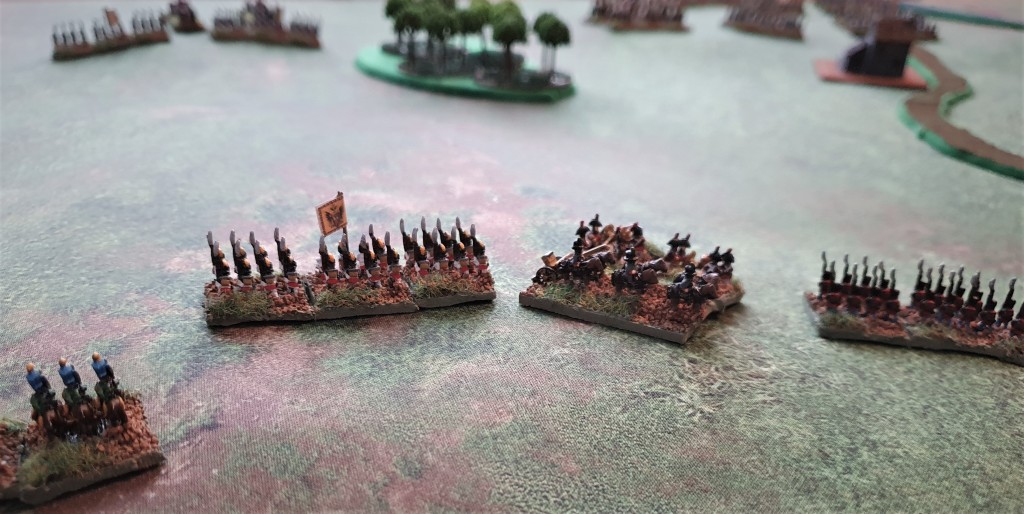
Left flank: My artillery deployed in a way to reach up to the village in the center (upper left).

Center: My brigade on attack order in the foreground using the road to advance. To the left next to the heavy cavalry reserve you can see a lone rider. That’s me!

Right flank: This flank was easy defend even before AI deployed. To the left you can see light infantry holding a wooded area which connects my flank to the center.

Turn 3 left flank: The enemy steadily advances while my artillery bombards enemy Dragoons.

Turn 3 center: On the right my brigade has reached its designated position on the hill and artillery is about to unlimber. My other brigade is checked early by enemy Dragoons. Overall my deployment was a bit shoddy and gave the French time to close quickly. The speed of Dragoons certainly helped. This turn the French also released a limited amount of reserves to support the push. With AI you have to roll every turn if reserves are released and to what amount.

Turn 4 center: A view from the central hill. My artillery deployed and help to disperse light infantry in front of it. The French struggle to redress the lines.

Turn 5 left flank: By turn 5 the battle is in full swing. The enemy deployed his artillery in support and blasts my left flank. I don’t have enough forces to push aggressively.

Turn 5 between left flank and center: The quick push by enemy Dragoons is checked in turn by my infantry and artillery. The French cannot charge as the odds would be bad in a frontal charge.
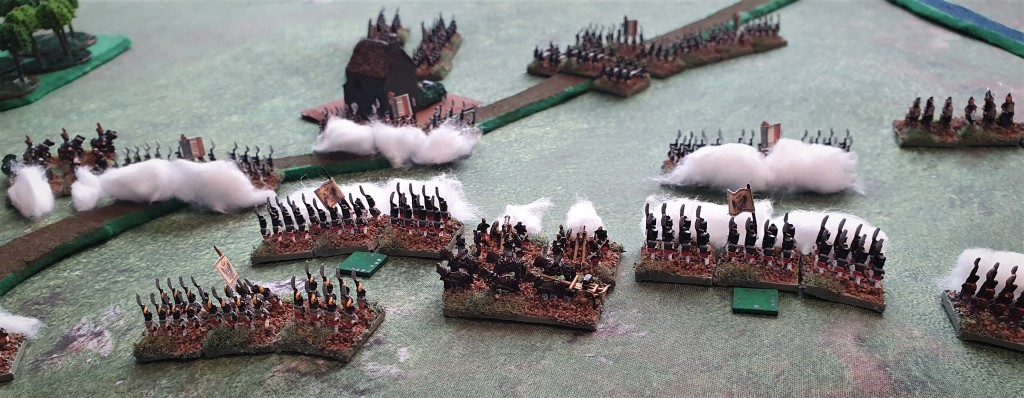
Turn 5 center: Thick clouds of smoke envelop the center as the attritional firefight begins. The situation looks stable for me but my frontline troops are suffering and my line will be stretched thin soon if I can’t do anything about it. Meanwhile the French still have reserve forces in the back.
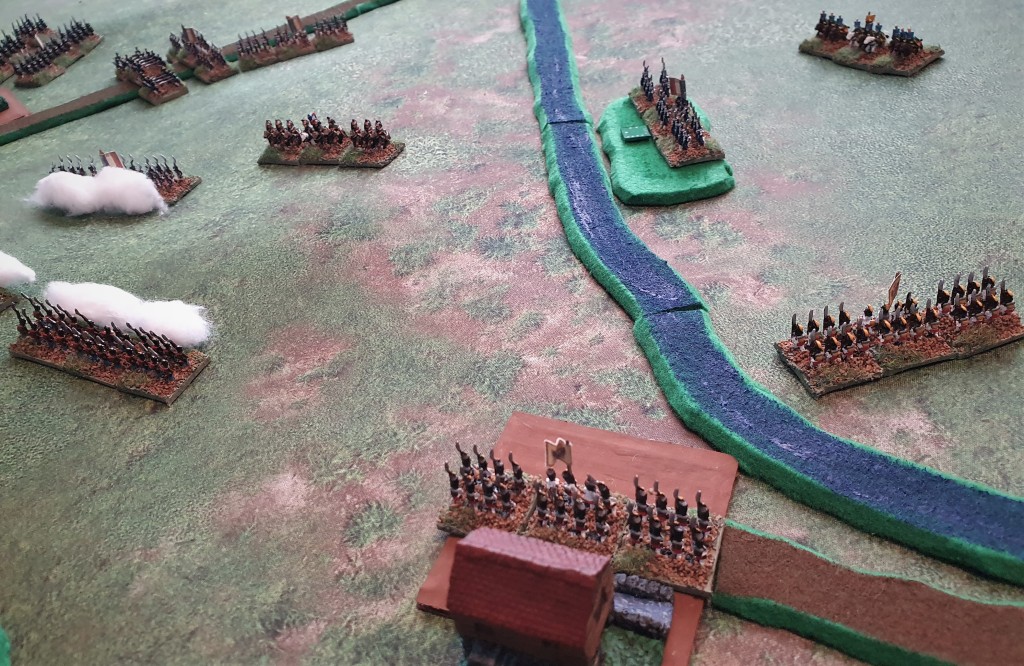
Turn 5 right flank: After initial defense my forces are ordered forward in a flanking move. A lone enemy line infantry unit holds the woods.
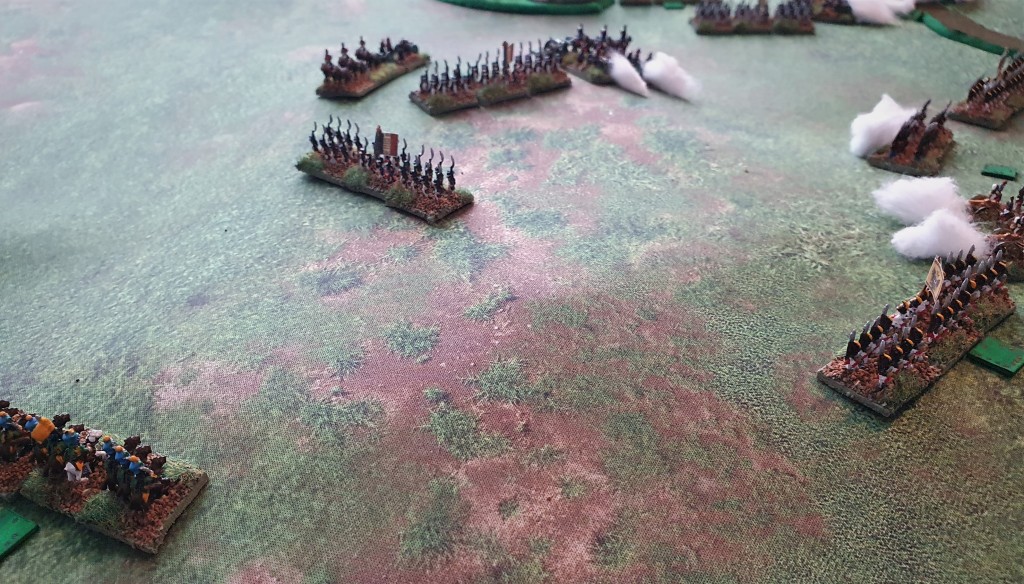
Turn 8 left flank: This flank gives under constant artillery fire and a bold infantry charge. I’m scrambling to reform my line around my cavalry reserve (just right out of the image).

Turn 8 a general’s view: The brigade once ordered to capture the central village has lost another unit. The center is beginning to look thin. In the distance you can catch a glimpse of enemy Dragoons retiring. They have taken too many hits and are relegated to a support role.

Turn 8 center: Both sides are losing units but the French keep coming (from reserve).
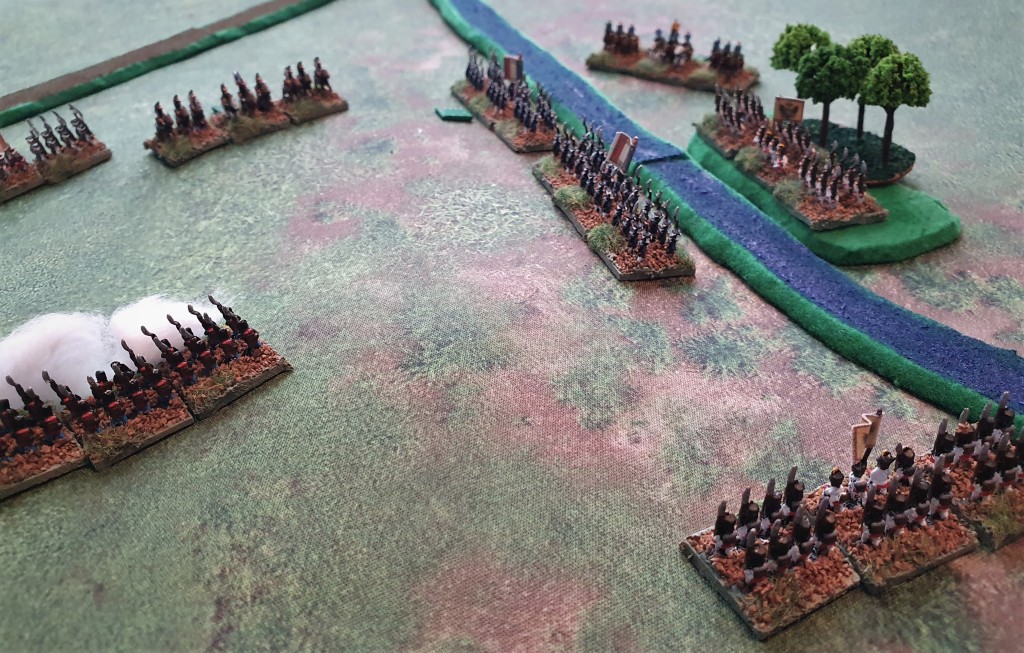
Turn 8 right flank: The French have retired behind the river and reinforced this sector with their last reserve. Both sides are maneuvering into firing positions.

Turn 10 left flank viewed from general: The game ended on turn 10. Here you can see my reformed line with reserve cavalry. The Cuirassiers charged this turn but were beaten back by canister fire.
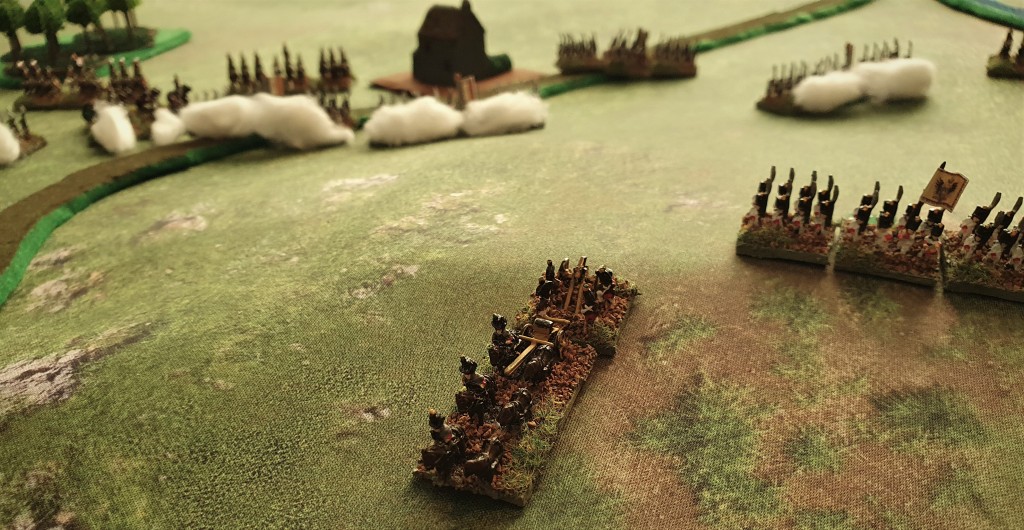
Turn 10 center: The remnants of my center brigade turn and run. This is the reason I ended the game. With a collapsed center the Austrian position becomes untenable. As you can see there are still more than enough French soldiers behind the wall of smoke.

Turn 10 right flank: Here I am still in a good position. My troops in the foreground are fresh and most enemy units are worn down and close to breaking. Though with a broken center both flanks will be isolated and defeated in detail.
Both sides lost 4 units out of 15 (without artillery) and had multiple units low on hits. As the Austrian cavalry reserve is still fresh I judged this battle to be a clean French victory but not one that is strategically decisive.
Thoughts on Simplicity in Practice
I think, the system does what it sets out to do. After a few turns I memorized the important stats and the game flowed quickly. Melee takes more looking up as it has a list of modifiers you have to read carefully. It may be due to the larger number of units I deployed but melee seems almost suicidal for the attack in most situations. Modifiers have a massive impact on the result and the outcome is massive as well. In part this does reflect my reading but it is too hard to pull off. You would need a entire line of light infantry to soften up the enemy and then coordinate a fall back of the light infantry and an advance into melee with line infantry along the entire line. Even then your chances seem about even at best. All in all the game felt more 18th century than Napoleonic. I think at the battalion/regiment level formations and skirmishing are almost necessary to model in your rules in order to see Napoleonic tactics employed on the battlefield.
This criticism should not detract from the fact that SIP is a good and elegant set of rules in my opinion. Movement works is dead simple but works very well. It takes some time playing to see that it is actually difficult to extricate units from firefights. All because the movement rules make sense and not because added mechanics like disruption are used. The rules have several such gems of design. Together with the scenarios presented in the surrounding issues of the Battlegames magazine and the article in volume 22 about the genesis and use of simple rule sets you get quite a bit of material.
Thoughts on Adjutant Introuvable
An interesting system albeit limited. It emphasizes the general plan and deployment much more than actual gameplay. It gave a weighted and believable plan of attack but only if you play accordingly and give the system some leeway. It also can only attack. A defending enemy can easily played without AI of course but that’s not what I meant. Almost all its strategies are rather strong attacks and the tactical strategies cannot switch to retiring if an attack fails. With the terrain set up as is the better strategy would have been to use the central village as strongpoint.
Again, this critique should not detract from AI’s value. It delivered a good simulation of the command of an army where not everything goes like planned and troops are at times rather plodding, at other time surprisingly quick. I have a feeling that much hinges on the amount of troops, the battlefield terrain and especially the rules used. I will definitely give AI another try with another set of rules.
Thoughts on the Combination
During the game I was in the commander’s mindset of how and where to use my forces and saw with desperation how my situation got progressively worse. I was a bit dismayed by the tactical limitations of SIP in regards to attacking. In hindsight I see this battle in a different light. It was in essence quite Napoleonic in that two plans clashed with each other and all the commanders could do is use reserves to sway the battle in their favor. The French one was larger and released at the right time, mine was not.

I thought it gave a very good Napoleonic game. The French did not, though, seem to go in for column of attack. Or it didn’t sound like they did.
It may be the rules didn’t reflect the importance of light Infantry sufficiently for them to be effective
LikeLike
The rules do not use formations as they would add more complexity. March movement is abstracted by a simple bonus to movement speed on roads, though. So I formed every unit in a line to make the unit frontages fit. But this makes the absence of assault columns doubly problematic as it doesn’t look quite right and infantry doesn’t have the initial impact for a successful attack. I think melee more along the lines of DBA would fit better here.
LikeLike
I enjoyed this battle report a lot! I like seeing your battle plan sketch and reading of your post-game thoughts. Nice BatRep too.
I am not familiar with either SiP or AI but I did watch part of the video for AI.
LikeLike
Very nice battle report I have shared your post here https://wargames-directory.com/forums/topic/simplicity-in-practice-and-adjutant-introuvable/
Why not join and share your future work
Take care
Andy
LikeLike
The melee rules in SiP are brutal. Pretty much one factor in your favour will almost guarantee you a win, since they shift the odds so much in that side’s favour. Unfortunately the designer’s notes article doesn’t touch on this so it’s hard to tell if that’s deliberate or just simply not very well thought out.
LikeLike
True. The interesting part is, that it makes situations really clear cut. It seems not like a gamble to attack (like with rule systems) but like suicide. It certainly gave more weight to reserves but I have to play more battles to come to a conclusion about the system.
LikeLike